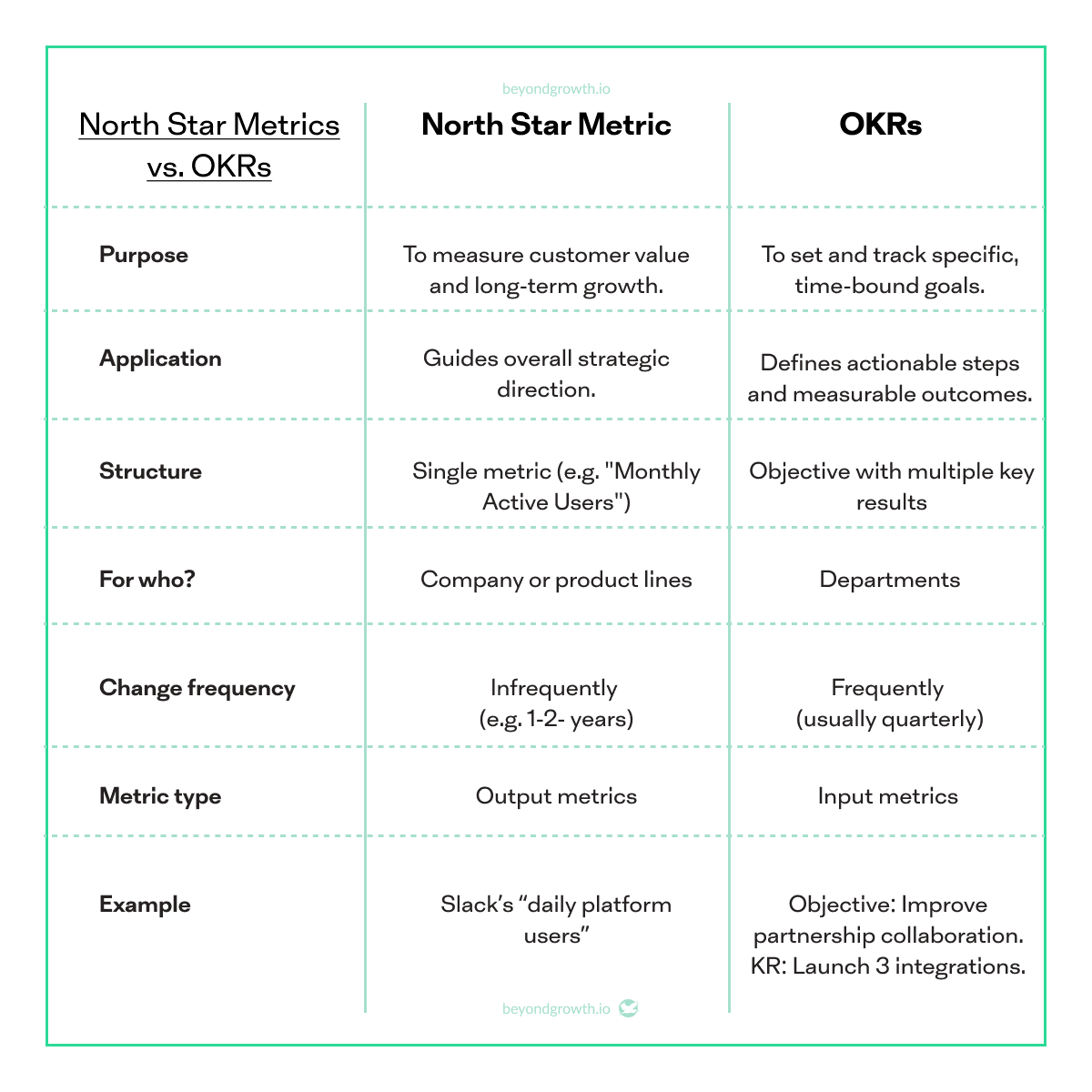Discovering your North Star Metric: choosing, measuring and understanding.
Discovering your North Star Metric: choosing, measuring and understanding.
What is a North Star Metric and how to identify yours.
What is a North Star Metric and how to identify yours.
Last edited on:
Oct 31, 2024
Author:
Jordy Oost



The North Star Metric
The North Star Metric (NSM) is a single measurement that captures the core value your product or service provides. This metric acts as a guiding focus for driving growth and aligning activities across the company.
By identifying a clear NSM, companies can stay focused on a growth goal that aligns teams and tactics. A strong north star metrics indicates long-term success, as it (1) reflects value for customers, (2) drives revenue, and (3) measures long-term company growth. That’s why it is important for the NSM to encompass broader success indicators and support long-term objectives.
The North Star Metric
The North Star Metric (NSM) is a single measurement that captures the core value your product or service provides. This metric acts as a guiding focus for driving growth and aligning activities across the company.
By identifying a clear NSM, companies can stay focused on a growth goal that aligns teams and tactics. A strong north star metrics indicates long-term success, as it (1) reflects value for customers, (2) drives revenue, and (3) measures long-term company growth. That’s why it is important for the NSM to encompass broader success indicators and support long-term objectives.



In this article, we’ll discuss how to find your North Star Metric, explore examples from successful B2B companies, and explain how an NSM can evolve—or even expand to include multiple metrics—as a company grows.
In this article, we’ll discuss how to find your North Star Metric, explore examples from successful B2B companies, and explain how an NSM can evolve—or even expand to include multiple metrics—as a company grows.
Identifying your North Star Metric
Finding your North Star Metric starts with understanding your customers' primary needs and the unique value your product or service delivers. To identify an NSM that drives sustainable growth, it’s essential to consider its characteristics. Subsequently, there is a list of questions to make sure your NSM guides you into the right direction.
2.1 Characteristics and examples
1 - Focus on customer value:
The most impactful NSMs reflect the core value your customers derive from your product.
For instance, Salesforce uses “number of monthly active users” to gauge how much its CRM platform supports clients’ productivity. This metric ensures that Salesforce's teams stay focused on enhancing the platform’s usability and client satisfaction.
2 - Link to revenue growth:
For B2B companies, the NSM should (indirectly) drive revenue.
Zoom, for example, emphasizes “number of minutes of use” to reflect both customer reliance and expansion opportunities. This NSM helps Zoom’s team focus on delivering value that encourages usage growth, which directly supports customer retention and upselling.
3 - Indicator of long-term success:
An effective NSM serves as a stable metric that aligns with your company’s long-term goals.
Atlassian measures “active monthly team collaboration” in its Jira software, a metric that indicates the platform’s relevance and impact over time. By focusing on this NSM, Atlassian can ensure that product updates enhance team collaboration, which is key to retaining long-term clients.
2.2 Questions to validate your North Star Metric
The following 8 questions, formulated by Ward van Gasteren, are a great way to validate your North Star Metric. A clear NSM answers yes to all of the below:
When do customers reach end-result?
Does this apply to all our customers?
Is this moment measurable for us?
What the best frequency? (day/week/month)
Do external factors have a minimal impact?
Is the NSM-growth tied to business-growth?
Does the full funnel impact my NSM?
Does my NSM metric change frequently?
Identifying your North Star Metric
Finding your North Star Metric starts with understanding your customers' primary needs and the unique value your product or service delivers. To identify an NSM that drives sustainable growth, it’s essential to consider its characteristics. Subsequently, there is a list of questions to make sure your NSM guides you into the right direction.
2.1 Characteristics and examples
1 - Focus on customer value:
The most impactful NSMs reflect the core value your customers derive from your product.
For instance, Salesforce uses “number of monthly active users” to gauge how much its CRM platform supports clients’ productivity. This metric ensures that Salesforce's teams stay focused on enhancing the platform’s usability and client satisfaction.
2 - Link to revenue growth:
For B2B companies, the NSM should (indirectly) drive revenue.
Zoom, for example, emphasizes “number of minutes of use” to reflect both customer reliance and expansion opportunities. This NSM helps Zoom’s team focus on delivering value that encourages usage growth, which directly supports customer retention and upselling.
3 - Indicator of long-term success:
An effective NSM serves as a stable metric that aligns with your company’s long-term goals.
Atlassian measures “active monthly team collaboration” in its Jira software, a metric that indicates the platform’s relevance and impact over time. By focusing on this NSM, Atlassian can ensure that product updates enhance team collaboration, which is key to retaining long-term clients.
2.2 Questions to validate your North Star Metric
The following 8 questions, formulated by Ward van Gasteren, are a great way to validate your North Star Metric. A clear NSM answers yes to all of the below:
When do customers reach end-result?
Does this apply to all our customers?
Is this moment measurable for us?
What the best frequency? (day/week/month)
Do external factors have a minimal impact?
Is the NSM-growth tied to business-growth?
Does the full funnel impact my NSM?
Does my NSM metric change frequently?
Examples of North Star Metrics in B2B
To give you an example, let’s look at some successful B2B companies and the NSMs they use to drive focus and alignment.
>>> HubSpot - Monthly Active Teams
HubSpot focuses on “monthly active teams” as its NSM, which reveals customer satisfaction and long-term usage. By concentrating on team engagement rather than individual users, HubSpot can drive product improvements that benefit the entire organization rather than focusing on short-term individual metrics. (source)
>>> Dropbox - Paid Users
Dropbox uses “number of paid users” as its NSM, emphasizing revenue growth directly linked to customer satisfaction. This metric aligns Dropbox’s marketing, sales, and product development strategies to convert free users into paid customers, indicating the platform’s long-term value and usability. (source)
>>> Slack - Daily Active Users (DAU)
For Slack, the number of daily active users reflects the platform’s value as a collaboration tool. Higher DAUs indicate strong user engagement, which in turn drives subscription renewals and upgrades. This metric encourages Slack’s product team to focus on features that foster collaboration and engagement. (source)
Each of these examples shows how B2B companies link their NSMs to core value drivers, creating alignment across teams while keeping the primary growth metric front and center.
Examples of North Star Metrics in B2B
To give you an example, let’s look at some successful B2B companies and the NSMs they use to drive focus and alignment.
>>> HubSpot - Monthly Active Teams
HubSpot focuses on “monthly active teams” as its NSM, which reveals customer satisfaction and long-term usage. By concentrating on team engagement rather than individual users, HubSpot can drive product improvements that benefit the entire organization rather than focusing on short-term individual metrics. (source)
>>> Dropbox - Paid Users
Dropbox uses “number of paid users” as its NSM, emphasizing revenue growth directly linked to customer satisfaction. This metric aligns Dropbox’s marketing, sales, and product development strategies to convert free users into paid customers, indicating the platform’s long-term value and usability. (source)
>>> Slack - Daily Active Users (DAU)
For Slack, the number of daily active users reflects the platform’s value as a collaboration tool. Higher DAUs indicate strong user engagement, which in turn drives subscription renewals and upgrades. This metric encourages Slack’s product team to focus on features that foster collaboration and engagement. (source)
Each of these examples shows how B2B companies link their NSMs to core value drivers, creating alignment across teams while keeping the primary growth metric front and center.
Can we help?
Are you in search of a Growth Marketer?
Fill in the form and get in touch
Want to learn about Growth Marketing?
Fill in the form and let's connect
Evolving your North Star Metric over time
A North Star Metric (NSM) can evolve as a company matures. Initially, one metric may capture core value, but as customer needs and products expand, the NSM may need adjustments. Here’s how to approach it:
Product Expansion: As new products or services are introduced, a single NSM may no longer capture the full value provided. Some companies add contributory NSMs for each product line to support an overarching metric, ensuring each product’s growth aligns with overall goals.
Changing Customer Needs: As customers’ needs evolve, the NSM may need refinement to better capture these shifts. LinkedIn, for example, shifted focus from “connections” to “engagement,” reflecting deeper value as user interactions became more nuanced.
Scaling Complexity: As organizations grow, they may create team-specific metrics aligned with the main NSM. Each department (e.g., sales focusing on leads, support on resolution times) contributes to the company’s NSM, fostering cross-departmental alignment.
Periodically revisiting your NSM helps ensure it continues to reflect your company’s growth and customer value, adapting as new priorities emerge.
Evolving your North Star Metric over time
A North Star Metric (NSM) can evolve as a company matures. Initially, one metric may capture core value, but as customer needs and products expand, the NSM may need adjustments. Here’s how to approach it:
Product Expansion: As new products or services are introduced, a single NSM may no longer capture the full value provided. Some companies add contributory NSMs for each product line to support an overarching metric, ensuring each product’s growth aligns with overall goals.
Changing Customer Needs: As customers’ needs evolve, the NSM may need refinement to better capture these shifts. LinkedIn, for example, shifted focus from “connections” to “engagement,” reflecting deeper value as user interactions became more nuanced.
Scaling Complexity: As organizations grow, they may create team-specific metrics aligned with the main NSM. Each department (e.g., sales focusing on leads, support on resolution times) contributes to the company’s NSM, fostering cross-departmental alignment.
Periodically revisiting your NSM helps ensure it continues to reflect your company’s growth and customer value, adapting as new priorities emerge.
The North Star Metric vs. Objective Key Results (OKRs): the difference
While both North Star Metrics (NSMs) and Objectives and Key Results (OKRs) help organizations set and achieve goals, they serve distinct purposes and function differently within a business.
NSMs focus on a single, customer-centered metric that reflects the company’s core value and long-term growth potential. In contrast, OKRs are a framework for setting specific, time-bound goals that align teams and measure progress toward broader strategic objectives. To clear things up, here is a comparison:

>>> For an introduction to OKRs, take a look at our article on this topic.
The North Star Metric vs. Objective Key Results (OKRs): the difference
While both North Star Metrics (NSMs) and Objectives and Key Results (OKRs) help organizations set and achieve goals, they serve distinct purposes and function differently within a business.
NSMs focus on a single, customer-centered metric that reflects the company’s core value and long-term growth potential. In contrast, OKRs are a framework for setting specific, time-bound goals that align teams and measure progress toward broader strategic objectives. To clear things up, here is a comparison:

>>> For an introduction to OKRs, take a look at our article on this topic.
In conclusion
Defining a clear North Star Metric has often allowed me to identify the core value my clients products and services provided. Subsequently, it can be used to align every department with a shared objective.
For example, when working at a SaaS platform, we focused on “weekly active users” as our NSM which enabled us to understand and increase our impact on created value for prospects and customers. This NSM clarified our product roadmap, helped identify growth opportunities, and kept us customer-centric as the company grew.
Using the North Star Metric effectively is about keeping it customer-centered, adaptable, and closely aligned with your long-term goals. A well-chosen NSM doesn’t just track performance—it pushes an organisation toward sustainable growth.
Can we help?
Are you in search of a Growth Marketer?
Fill in the form and get in touch
Want to learn about Growth Marketing?
Fill in the form and let's connect
Stay up to date
Subscribe to receive the newest articles
The Beyond Growth Blog publishes montly content about driving growth in early stage companies, entrepreneurship and accelerating efficiency in B2B marketing operations.

© 2023 Beyond Growth
© 2023 Beyond Growth



